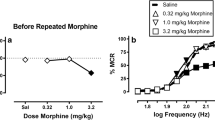Abstract
Negative (aversive) and positive (self-stimulation) intracranial reinforcement thresholds were determined in rats using a “double staircase” psychophysical procedure. Morphine raised aversive thresholds at all doses tested, while the drug lowered positive reinforcement thresholds at low or moderate doses. The results suggest the possible involvement of central motivational systems in the mediation of morphine-induced analgesia, the narcotic “high”, and narcotic addiction.
Similar content being viewed by others
References
Adams, W. J., Lorens, S. A., Mitchell, C. L.: Morphine enhances lateral hypothalamic self-stimulation in the rat. Proc. Soc. exp. Biol. (N. Y.) 140, 770–771 (1972)
Albe-Fessard, D.: Organization of somatic central pathways. In: Contributions to sensory physiology. W. D. Neff, Ed., Vol. 3, pp. 101–156. New York: Academic Press 1967
Boren, J. J., Malis, J. L.: Determining thresholds of aversive brain stimulation. Amer. J. Physiol. 201, 429–433 (1961)
Casey, K. L.: Pain: A current view of neural mechanisms. Amer. Scient. 61, 194 to 200 (1973)
Collier, H. O. J.: Supersensitivity and dependence. Nature (Lond.) 220, 228–231 (1968)
Cornsweet, T. N.: The staircase-method in psychophysics. Amer. J. Psychol. 75, 485–491 (1962)
Crowder, W. F., Smith, S. G., Davis, W. M., Noel, J. T., Coussens, W. R.: Effect of morphine dose size on the conditioned reinforcing potency of stimuli paired with morphine. Psychol. Rec. 22, 441–448 (1972)
Delgado, J. M. R., Roberts, W. W., Miller, N. E.: Learning motivated by electrical stimulation of the brain. Amer. J. Physiol. 179, 587–593 (1954)
Dews, P. B., Morse, W. H.: Behavioral pharmacology. Ann. Rev. Pharmacol. 1, 145–174 (1961)
Dixon, W. J., Massey, F. J.: Introduction to statistical analysis. New York: McGraw-Hill 1957
Domino, E. F., Olds, M. E.: Effects of d-amphetamine, scopolamine, chlordiazepoxide and diphenylhydantoin on self-stimulation behavior and brain acetylcholine. Psychopharmacologia (Berl.) 23, 1–16 (1972)
Gangloff, H., Monnier, M.: The topical action of morphine, levorphanol (levorphan) and the morphine antagonist levallorphan on the unanesthetized rabbit's brain. J. Pharmacol. exp. Ther. 121, 78 (1957)
Huston, J. P., Mills, A. W.: Threshold of reinforcing brain stimulation. Commun. behav. Biol. 5, 331–340 (1971)
Kelly, D. D., Glusman, M.: Aversive thresholds for subcutaneous electrical stimulation in the cat. Psychon. Sci. 1, 207–208 (1964)
Kelly, D. D., Glusman, M.: Aversive thresholds following midbrain lesions. J. comp. physiol. Psychol. 66, 25–34 (1968)
Kumar, R., Mitchell, E., Stolerman, I. P.: Disturbed patterns of behavior in morphine tolerant and abstinent rats. Brit. J. Pharmacol. 42, 473–484 (1971)
Latz, A., Bain, G. T., Kornetsky, C.: Attenuated effect of chlorpromazine on conditioned avoidance as a function of rapid acquisition. Psychopharmacologia (Berl.) 14, 23–32 (1969)
Lenzer, I. I.: Differences between behavior reinforced by electrical stimulation of the brain and conventionally reinforced behavior: An associative analysis. Psychol. Bull. 78, 103–118 (1972)
Lorens, S. A., Mitchell, C. L.: Influence of morphine on lateral hypothalamic self-stimulation in the rat. Psychopharmacologia (Berl.) 32, 271–277 (1973)
Malis, J. L.: The effects of analgesic drugs on two self-adjusting escape techniques in rhesus monkeys. Fed. Proc. 23, 284 (1964)
Mehler, W. R.: Some observations on secondary ascending afferent systems in the central nervous system. In: Pain. R. S. Knighton and P. R. Dumke, Eds., pp. 11–32. New York: Little, Brown 1966
Nelsen, J. M.: Single dose tolerance to morphine sulfate: Electroencephalographic correlates in central motivational systems. (Doctoral dissertation, Boston University). Ann Arbor, Mich.: University Microfilms, 1970. No. 70-22425.
Nelsen, J. M., Kornetsky, C.: Morphine-induced EEG changes in central motivational systems: Evidence for single-dose tolerance. Fifth Int. Congr. Pharmacol., p. 166 (1972)
Olds, J., Milner, P.: Positive reinforcement produced by electrical stimulation of the septal area and other regions of the rat brain. J. comp. physiol. Psychol. 47, 419–427 (1954)
Olds, J., Travis, R. P.: Effects of chlorpromazine, meprobamate, pentobarbital and morphine on self-stimulation. J. Pharmacol. exp. Ther. 128, 397–404 (1960)
Pellegrino, L. J., Cushman, A. J.: A stereotaxic atlas of the rat brain. New York: Appleton-Century-Crofts 1967
Sem-Jacobsen, C. W., Torkildsen, A.: Depth recording and electrical stimulation in the human brain. In: Electrical studies on the unanesthesized brain. E. R. Ramey and D. S. O'Doherty, Eds., pp. 275–290. New York: Paul B. Hoeber 1960
Stein, L., Ray, O. S.: Brain stimulation reward “thresholds” self-determined in rat. Psychopharmacologia (Berl.) 1, 251–256 (1960)
Valenstein, E. S.: Problems of measurement and interpretation with reinforcing brain stimulation. Psychol. Rev. 71, 415–437 (1964)
Valenstein, E. S.: History of brain stimulation: Investigations into the physiology of motivation. In: Brain stimulation and motivation. Research and commentary. E. S. Valenstein, Ed., pp. 1–43. Glenview. Ill.: Scott, Foresman 1973
Weiss, B., Laties, V. G.: Titration behavior on various fractional escape programs. J. exp. Anal. Behav. 2, 227–248 (1959)
Woods, J. H., Schuster, C. R.: Reinforcement properties of morphine, cocaine and SPA as a function of unit dose. Int. J. Addict. 3, 231–237 (1968)
Woodworth, R. F., Schlosberg, H.: Experimental psychology. New York: Holt, Rinehart, and Winston 1954
Author information
Authors and Affiliations
Additional information
This paper is based on a dissertation submitted by the first author in partial fulfillment of requirements for the Ph. D. degree in the Department of Psychology, Boston University, and was supported in part by grants MH 12568 and DA 00257 from the National Institute of Mental Health.
Rights and permissions
About this article
Cite this article
Marcus, R., Kornetsky, C. Negative and positive intracranial reinforcement tresholds: Effects of morphine. Psychopharmacologia 38, 1–13 (1974). https://doi.org/10.1007/BF00421282
Received:
Revised:
Issue Date:
DOI: https://doi.org/10.1007/BF00421282




